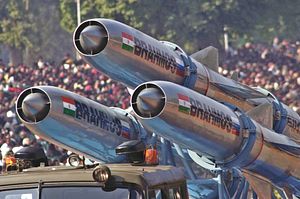The Indian Ministry of Defense’s (MoD) research arm, the Defense Research Development Organization (DRDO), is expected to test fire an extended-range supersonic BrahMos cruise missile by the end of 2018, according to Indian government officials quoted by local media outlets last week.
The Indian Air Force (IAF) will test fire the extended-range air-launched variant of the BrahMos, designated BrahMos-ER, from a Sukhoi Su-30 MKI multirole air superiority fighter jet. The new missile will purportedly be capable of hitting targets at a distance of up to 800 kilometers.
In March 2017, DRDO for the first time test fired a BrahMos-ER missile with a “much higher range than the current range of 290 km,” the Indian Ministry of Defense cryptically noted. Estimates put the range of the tested missile at 400-600 kilometers. Increasing the missiles’ range became possible after India joined the Missile Technology Control Regime in June 2016.
The new 800-kilometer range BrahMoS-ER could be an indication that India will deploy the BrahMos as part of the air component of its nuclear triad. Analysts believe that the BrahMos can be modified into a nuclear-capable missile. The Indian MoD until now has not publicly confirmed that it is seeking a nuclear capability for the supersonic cruise missile.
The IAF last test fired an air-launched BrahMos-A supersonic cruise missile from a Sukhoi Su-30 MKI in December 2017. Two IAF Su-30 MKI fighter jets so far been converted to fire the 2.5-ton supersonic air-to-surface cruise missile. The IAF plans to retrofit up to 40 Su-30 MKI’s to carry and launch the BrahMos-A.
Upgrades to the aircraft include a reinforced undercarriage next to a number of mechanical, electrical and software upgrades. In order to carry nuclear-tipped BrahMos missiles, the Su-30 MKI would also need to be retrofitted with hardened electronic circuitry to withstand the electromagnetic pulses of a nuclear blast.
Each Su-30 MKI can only carry one missile in a transport launch canister. Around 50 Su-30MKI aircraft will undergo upgrades by the early 2020s.“The Sukhoi has a range of 3,600 km. Arming it with an 800-km range missile will increase its reach tremendously, and even more, considering the option of midair refuelling,” an Indian government official told the Hindustan Times.
The BrahMos, a joint venture between India’s Defense Research Development Organization and Russian rocket design bureau NPO Mashinostroyeniya, “operates on a so-called fire and forget principle and can be dropped from 500 to 14,000 meters (1,640 to 46,000 feet),” I explained elsewhere.
“The missile’s terminal altitude is as low as ten meters. (The ship-launched anti-ship version of the BrahMos can fly 3-4 meters above the sea to avoid detection.) The BrahMos is capable of traveling at speeds of up to Mach 3.0, making it one of the world’s fastest cruise missiles.”
The land-launched and sea-launched variants of the BrahMos are already in service with the Indian Army and Navy. The IAF’s air-launched variant is expected to become operational by the end of 2018.

































